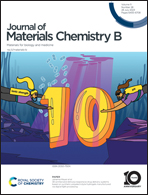In situ cyclodextrin metal–organic framework/electrospun composite fibers with biosafety for the removal of volatile organic compounds†
Abstract
Volatile organic compounds (VOCs) are one of the most common air pollutants, which threaten human health seriously. Fibrous textile is one of the most popular matrices for VOC removal in daily life. In this study, biosafe cyclodextrin metal–organic framework/polycaprolactone (CD-MOF/PCL) electrospun fibers were prepared via a CD precursor doping method, followed by hydrothermal treatment in methanol vapor diffusion. In situ CD-MOF crystals with a high loading of more than 50 wt% densely covered the surface of the electrospun fibers. The CD-MOF/PCL composite fibers show similar stress–strain behavior to the electrospun PCL fibers. The analysis of the fractured zone indicated that the compatibility of CD-MOF/PCL fibers was excellent, and CD-MOF showed no obvious peeling-off, even at low temperatures. The hemolysis rate of less than 1% confirms the biosafety of the composite materials. Further, the CD-MOF crystals anchored onto the fibers promote their VOC uptakes significantly. The CD-MOF/PCL fibrous matrix, which demonstrated compatibility, excellent strength, and biosafety would be beneficial to develop novel equipment to purify air pollution.



 Please wait while we load your content...
Please wait while we load your content...